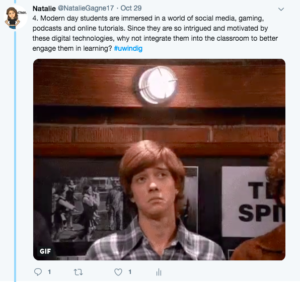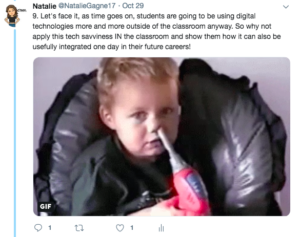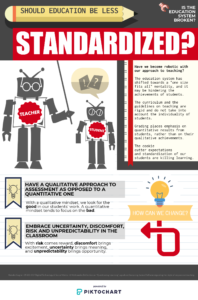I chose to do a Twitter essay for my reflection. I thought that the Technologist module presented some useful info, but was also not organized in the most effective manner.
I enjoyed the Empathize section of the module. I found this particularly relevant to the teaching world as they explained that: “Design thinking starts with empathy. When you design something that is going to be used by someone else—a lecture, an activity, an assessment—you must first understand what that person needs.” Teachers should constantly be putting the needs of their students before their own when it comes to designing lessons, and the same can be said about technology integration.
Although the module explained some interesting strategies and concepts, a lot of them seemed intuitive for someone who is somewhat tech-savvy. I think the platform is better suited for those who are not confident with technology and really need extra help with digital literacy.
In all honesty, I thought the platform quite overwhelming and felt as though I was being overloaded with information that wasn’t the most engaging to read. I found myself ‘shutting down’ every time I went through a new section because it seemed like I was entering a never ending labyrinth of hyperlinks which unlocked pages upon pages upon pages. I soon had more than 20 tabs open on my browser and just wanted to shut the whole thing down. I am someone who likes order and simplicity when it comes to my work, so having no guidelines for the website and never knowing what I was getting myself into when starting a new section was daunting. I found myself quickly clicking through everything and not actually retaining any information – I just wanted to get through it. I wonder if other readers felt the same way and focused only on reaching the finish line, rather than enjoying the ride and taking in the sights. I think a ‘learning goals’ list or a timeline would have helped me better visualize what I should take home from each section and have an idea in mind of how much time/energy each section will take me. Overall, I felt like I learned a lot more about myself and my learning style than I did about technology.
Something else I noticed and found ironic: the Design Thinking section had (yet another) hyperlink for readers to explore. When I clicked on it, it took me to a Wikipedia page that explained what Design Thinking is. I personally enjoy and frequent Wikipedia for basic knowledge of topics, but I found it quite digitally illiterate for a website to directly send it’s readers to Wikipedia for a definition. No? Just me?
Lastly, it seemed like this Extend site offering the Technologist module didn’t actually contain much of its own information. It seemed as though most of the learning would occur through exploring other websites. I think that Extend would be better off summing up the other sites in their own words for their readers in organized sections, rather than just sending them to what felt like a bijillion different websites.
Anwyay, I summed up my thoughts in the Twitter essay below. Have a read through my rant and see if you can resonate with my thoughts. Maybe I’m just being a little extra with the complaining, but it is meant to be a reflection after all, right?
– Nat G
2. The module is broken down into several sections which, at first glance, look like bite sized chunks of material. But upon digging a little deeper into the platform, I found the sections to be quite lengthy and to be honest, overwhelming and seemingly never-ending.#UWINDIG pic.twitter.com/X0ldSmHx5E
— Natalie (@NatalieGagne17) February 21, 2019
4. The module is broken down into several sections, one of which focuses on Design Thinking. The core principle of design thinking is that it is human-centered; The people who will benefit from the product or solution are directly involved in its design. pic.twitter.com/qKIqaQYMnr
— Natalie (@NatalieGagne17) February 21, 2019
6. Isn't it ironic that a website intending to teach us about technology and digital literacy is referencing a Wikipedia page? I would have rather seen a definition in the website's own words. I mean, I personally love Wikipedia and frequent it for basic info. But really?#UWINDIG pic.twitter.com/V4qc48FCIA
— Natalie (@NatalieGagne17) February 21, 2019
8. Students should be the core focus of our lesson plans and their needs should be prioritized before our own as teachers. We should look at situations through their eyes and make the learning experience as valuable as possible for them. #UWINDIG pic.twitter.com/SsgTeVvvxF
— Natalie (@NatalieGagne17) February 21, 2019
10. In addition, there seemed to be an endless amount of hyperlinks. I felt as thought I was in a never ending labyrinth of clicking and soon found myself to have 20+ tabs open on my browser at once. I would have enjoyed the module more if everything was in one place. #UWINDIG pic.twitter.com/3ULwIIrGt6
— Natalie (@NatalieGagne17) February 21, 2019
12. Overall I thought this module had some great ideas and great resources for teachers to expand their technological knowledge. I think it would be a good resource for those who aren't very tech-savvy, but for someone who is, the information may not be resourceful to them. pic.twitter.com/Wbe1DEKEbP
— Natalie (@NatalieGagne17) February 21, 2019
13. The quality of information was there, but I think the site could have been better organized and a timeline/learning goals list would have made my experience better. I think that readers could easily get lost in the abundance of information and become overwhelmed. #UWINDIG pic.twitter.com/QETPMwYnZT
— Natalie (@NatalieGagne17) February 21, 2019



